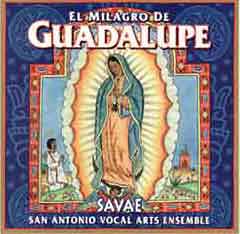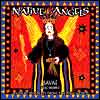
BY COVITA MARONEY, USA

SAVAE decodes lost Aztec music system
to record Nashua and Aztec Indian music
In October 1999 The San Antonio Vocal Arts Ensemble released its third recording on the IAGO/Talking Taco label: El Milagro de Guadalupe. In December SAVAE Artistic Director Christopher Moroney appeared on National Public Radio's Weekend Edition in an interview with host Liane Hansen. The new recording has received positive reviews by music critics from the Los Angeles Times, The Dallas Morning News, as well as from SAVAE's home town paper, the San Antonio Express-News, among others. In January 2000 the ensemble was invited to present a concert for the annual conference of The American Guild of Cathedral Musicians, a group of several hundred music directors from cities throughout Canada and the United States.
El Milagro de Guadalupe has been charting on the classical top seller lists for Allegro Records, amazon.com, and Borders Books and Music, and has sold over 20,000 copies worldwide.
SAVAE's second recording, Guadalupe, Virgen de los Indios hit the January 16, 1999 issue of Billboard magazine, where it ranked at number 11 on the Top World Music Albums chart. Last year National Public Radio's Weekend Edition aired an interview by Scott Simon, featuring music from that CD and a discussion with SAVAE artistic director, Christopher Moroney. That recording has sold over 30,000 copies and continues to chart on world and classical best seller lists.
The music SAVAE has included on the new recording, El Milagro de Guadalupe, comes from cathedral archives in Mexico and Guatemala, and has been transcribed from the original manuscripts by Sheila Raney Baird and Steven Barwick. The plainchant used on the recording is taken from the Liber Usualis edited by the Benedictines of Solesmes. The majority of pieces were composed by Nahua and Aztec Indians who had been converted to Christianity and musically trained by Spanish missionaries.
The performances on El Milagro de Guadalupe capture the Native Mesoamerican and Colonial Spanish musical styles that began to fuse during the colonial period in Mexico. SAVAE's use of Mesoamerican wind and percussion instruments is based on Aztec artwork and early paintings from the first decades following the Conquest. Instruments used include the huehuetl (vertical drum), teponaztli (horizontal log drum), huilacapitzli (clay flutes), atecocolli (conch shell trumpet), deer antlers, lajas (stones), chayahuatzli (rain stick), ayacaxtli (a variety of rattles and shakers), omichahuaztli (rasp), Native American flute, European recorders, tambourine, and guitar. The rhythms used are adapted from syllabic drumming patterns found in the codex Cantares Mexicanos, compiled in the 16th century by Aztec musicians and historians.
In 1531, ten years after the Spaniards conquered the great Aztec capital of Tenochtitlan, now Mexico City, the devout Nahua Indian Juan Diego saw a vision: a dark-haired, dark-skinned young woman surrounded by rays of resplendent light. She told him she was the mother of the true God and was there to love, help, and protect him and all those who placed their trust in her. According to sacred tradition, the apparitions took place from December 9th through the 12th, outside Tenochtitlan on the hillside of Tepeyac. In 1649 the story was recounted in great detail in the Nican mopohua, the Aztec oral history of Guadalupe which was published in Nahuatl by Luis Laso de la Vega, the vicar of the little church at Tepeyac. It is believed the story originally came from Juan Diego himself and was first put on paper sometime between 1540 and 1580 by Don Antonio Valeriano, a Nahua Indian and scholar who served as Indian governor of Mexico City for more than 35 years.
One of the biggest musical surprises for SAVAE came in the reconstruction of the song, Teponazcuicatl (Track 2) from the codex Cantares Mexicanos — a collection of pre- and post-Conquest Aztec songs that was compiled by a group of indigenous musicians and historians sometime between 1550 and 1580. Teponazcuicatl, originally an homage to the goddess of corn (one of the aspects of Tonantzin), is believed to have been reworked by the Aztecs to announce the miraculous apparitions at Tepeyac. Tradition says that on December 26, 1531, a triumphant procession accompanied by this song conveyed the image on Juan Diego's tilma from the Mexico City Cathedral to Tepeyac. SAVAE's stumbling block was that no written music exists for this or any other song in the Cantares, and no rhythmic structure or rhyming scheme is evident in the Nahuatl verses. However, a drum pattern in the form of onomatopoeic Nahua syllables (tico toco toco tiquitiquiti quiti quito) starts the song followed by the instruction: "Just thus it will come back in." By assigning pitches from the pentatonic scale of the Aztec huilacapitzli (clay flutes) to these syllables as well as adapting the syllabic pattern to the drums, a driving melodic and rhythmic figure emerged. Not only did the words fit the melody beautifully, but each verse formed a set of four melodic repetitions with the words rhyming at the end of each repetition! It felt as if we had "decoded" part of a musical system that had been recorded for posterity over 400 years ago.
The work of many musicologists and historians made the recording possible: Dr. Oscar García-Landois provided SAVAE with Sheila Raney Baird's transcriptions of the Santa Eulalia Manuscripts from Northwestern Guatemala — the source of Tomás Pascual's work; Father Daniel P. Jensen, discovered Pascual's manuscripts in a church attic in San Miguel Acatán in 1961; Robert Stevenson is known for his years of research in the repertoires of Spanish Colonial music; Peggy Sexton of Tactus Press in Austin, Texas provided information through her research of the Cantares Mexicanos; authors J. Richard Andrews, John Bierhorst, and Frances Karttunen have published excellent reference works on Nahuatl literature and linguistics; and authors Virgil Elizondo, Francis Johnston, Jacques Lafaye, and Stafford Poole, C.M., have each written extensively on Guadalupe.
SAVAE made its debut in December of 1989 with a concert in San Antonio's historic San Fernando Cathedral, the nation's oldest. Selections from its subsequent performances of early music from Latin America have been featured several times on National Public Radio's (NPR) Performance Today and Texas Public Radio's Musica Antigua. Highlights of the ensemble's performances include the world premiere of Edward Garza's Misa San Antonio under the direction of Christopher Wilkins with the San Antonio Symphony, and the premiere of Alice Gomez' Mass for Justice and Peace under the direction of Dr. Douglas R. Boyer. In September, 1997, the ensemble was featured in National Public Radio's historic live recording and radio broadcast from San Antonio's historic landmark, the Alamo.
SAVAE Artistic Director and baritone Christopher Moroney studied composition at the New England Conservatory of Music, and arranging and composition at the Berklee College of Music in Boston. The remaining members of the San Antonio Vocal Arts Ensemble are sopranos Paula Olsen and Kathy Mayer, altos Tanya Moczygemba and Covita Moroney, tenors Lee P Pool and Jody Noblett.
SEE LaMuSICAfe's NEW SOUNDS NEW RELEASES page in this issue of INSPIRE to order Milagro now!
VISIT SAVAE'S WEBSITE AND PUT IT IN YOUR FAVORITE'S LIST TO KEEP UP WITH CDs and CONCERT DATES
Bookings, Workshops, and Repertoire contacts:
Covita Moroney or Christopher Moroney, 12107 Magnolia Blossom, San Antonio, TX 78247
Telephone: +1 210 494 3674
Email: moroneys@ix.netcom.com

inside
tracks 2
"Grade A: nourishing to the body and soul." — Atlanta Journal-Constitution
"SAVAE has been enchanting diverse audiences nationwide." — Associated Press
"Miracles happen and this music proves it."
— The Austin Chronicle

